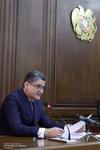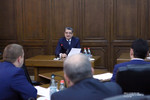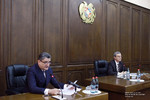Wednesday, 29 May 2013
National Assembly Statement By Prime Minister Tigran Sargsyan Regarding 2012 Budget Performance
Dear MPs,
Dear Colleagues,
I would like to draw your attention to several important provisions that characterize the budget performance for 2012. First of all, I will refer to macro-economic environment and the year-end indicators. It is important to understand what kind of environment we had for budget exercise and economic growth.
The actual summary of economic data showed that the economic recovery continued during the year leading to significant improvement of macroeconomic situation in 2012. However, the external environment deteriorated as compared to 2011 because of lower economic growth recorded in partner countries, and declining metal prices in the international markets.
It can be stated that the growth in 2012 was mainly driven by domestic factors, including the government’s industrial policy.
Amid the aforementioned developments, 7.2% economic growth was stated in 2012, contributed by all sectors of the economy: It is gratifying that the economic growth continued to be driven by the exports - a target that the government was set as early as in to 2009 in the wake of the financial crisis. Here, I should emphasize the launch of the government approved industrial strategy in December, 2011.
We can see that our action plan yielded positive results in 2012. In particular, boasting an actual rise of 7%, industry continues to positively affect the overall growth of 7.2 per cent with a share of 1.2 per cent. In turn, the processing sector was the locomotive of industry with a 1.9 per cent share.
Mining industry, too, boasted high growth rates up to 16.7 percent. While metals prices were not so favorable for the industry, the mining sector contributed to the industrial growth by 2.7 percent.
In 2012, industry contributed significant value added ensuring high levels of power and water supply, which rose 9.4 and 21.7 percent, respectively, as compared to last year.
As a result, by the end of 2012 the share of industry in GDP was 17.2% against the pre-crisis figure of 13.3%. This figure clearly shows that the economy is being diversified in favor of the real sector.
In agriculture, for the second consecutive year we have recorded high growth rates which stood at 9.5 per cent in 2012 with a 1.9 per cent share in the overall growth due to the government’s development programs and the impact of weather conditions. In particular, the government undertook a number of projects in 2011, including a large-scale loan interest rate subsidy program. As a result, AMD14.760bn loans were provided in 2012.
Due to state budget-allocated MAD568mn-worth subsidy, the loans were provided at the rate of 8-10%, which is far lower than the market one. Secondly, it should be noted that the government helped farmers get fertilizers and fuel at reduced prices.
In 2012, a subsidy of AMD1.433mn was provided for fertilizers, leading to the affordable cost of 6 thousand dram per bag covering some 30 thousand tons of nitrogenous fertilizers. Subsidy for fuel was provided to an amount of AMD1.948bn, resulting in 21.648 liters of diesel fuel at the cost of 350 dram per liter. 3,400 tons of wheat and barley seeds were made available to some 7 thousand 400 beneficiaries under the the government’s seed-breeding program.
As a result, wheat areas grew by about 17 thousand hectares in 2012. The gross crop of winter wheat amounted to 211 thousand tons in 2011 and 234 thousand tons in 2012.
The next is the cow-breeding program. We imported 485 heads of breeding heifer to a total cost of AMD466mn and distributed them among 24 businesses.
Real gross output in the cultivating sector grew by 14 percent, providing the main part of the annual growth in agriculture. Here it should be noted that the share of agriculture in GDP has increased to 19% as compared to the 16.3% of the pre-crisis year of 2008.
We boasted a 6.5% growth in the tertiary sector, as compared to last year’s increase of 4.7%.
The latter could be said to have been a driving force for economic recovery with a 2.5% share in the 7.2 percent growth. In fact, if we look at the structure of the services sector, the largest contribution to the growth was made by financial services and insurance activities - 2.4 percentage points, while insurance services foster the exports. As a result, the share of services in GDP rose to about 40% against 33% as recorded in the pre-crisis year of 2008.
A positive development in the economy is the fact that construction has been stabilizing recently. For the first time in 2012, we were able to state a 3.3% rise in construction after a protracted period of decline. Increased by 26.7%, private investments accounted for the bulk of the growth in construction. Down from 25.3% to 12.2%, the share of construction in GDP has shrunk by over twofold as compared to agriculture, industry and services.
Although slightly slower, positive developments can be noticed either in the external sector. The current account deficit fell by 0.3 percentage point. By the way, by stimulating the exports we managed a clear improvement in the export of manufactured goods and farm products in 2012. The improved current account balance, too, has contributed to the growth in the exports, the overall share of which went up to 25% in the GDP as compared to the 15% stated in the pre-crisis year. This is our most important achievement in the past 4 years.
We abode by coordinated fiscal and monetary policies in 2012. As a result, boasted a 3.2 percent planned inflation rate. The high pace of growth in agriculture was behind the said low inflationary environment. Approaches in our fiscal and monetary policies were both multi-dimensional and well-balanced.
Moreover, on the one hand, we had set the task of promoting economic recovery and, on the other hand, ensure effective debt management and phased reduction of the deficit through macroeconomic stability, as well as to collect more revenue, mainly at the expense of the shadow economy.
Noteworthy is the fact that managed a very high level of tax collection - about 22 percent – a 1.4% improvement over the previous year’s level. In parallel, our country’s external debt level was stabilized, and the medium-term risks are balanced at the moment.
It was also important to provide for timely and full implementation of the budget. To recall, AMD911bn was projected in revenue for 2012 against the background of planned 4.2% economic growth, of which 895 billion in the form of domestic receipts and 16 billion under foreign grants.
Based on statutory adjustments made by the government after getting the National Assembly’s approval of the State budget revenue index, the estimate of budget receipts was raised by AMD33bn to AMD944bn or by 3.6% of the overall target, of which 922 billion in domestic receipts and 22 billion in official grants. Thus, the planned aggregate target of tax revenue, State duties and mandatory contributions was met by 100%.
The budget expenditure performance was 93.4 percent in 2012, or 1,006 billion drams. The deviation was due to economies made under a number of programs, as well as to delayed payments for the procurements made under individual programs. It was partly due to the performance in foreign assistance programs.
The welfare sector reform was pushed ahead in 2012.
As of November 1, 2011, the base pension was increased to AMD13,000 instead of 10,500 drams For the first time in 2012, we spent some 12 billion drams under the program of welfare packages for the staff in public agencies and organizations.
Over 4 billion was spent to provide housing to the families left homeless after the devastating earthquake of 1988. A significant increase was recorded in the financing of the social security system - 13.9% equivalent to 35 billion drams, primarily due to the above program of welfare packages, the increase in the level of retirement pensions, family allowances, lump-sum benefits, as well as the funds borrowed from the Russian Federation and the earthquake-zone housing investments.
As a result, the share of welfare spending in GDP proved 1.1% higher than the target set by the government, and it now stands at 7.3 percent of GDP.
Financial management efficiency improved in the educational and healthcare sectors in 2012 in quality and accessibility terms amid maintained or reduced levels of public funding. Some 293 thousand citizens were provided healthcare services under the State order facility, and 52 thousand children under seven got free medical assistance in the period under review.
As far as infrastructure is concerned, last year was specific in terms of investment into the road infrastructures. AMD29bn was allocated from the State budget, a 19% increase over 2011. Roads and road sections to a total length of 182km were built or upgraded in 2012. The Asian Development Bank-supported North-South Transport Corridor project was launched in September, with some 7 billion drams spent in 2012 alone.
The government funded capital construction in the field of drinking and irrigation water supply to a total cost of AMD15 billion. As a result, 178km-long drinking water-mains and sewerages were built or renovated, along with 60 drinking water pump-stations, 10 drinking water reservoirs, 75 km-long irrigation water-mains and pipes, 30 irrigation pump-stations, 5 irrigation water reservoirs, 44 km-long drainage systems and 31 km-long main canals.
The next task was to improve the business environment in Armenia. The index of 2012 is reflected in the World Bank’s “Doing Business – 2013” report, according to which Armenia’s rating has improved by 18 points taking our country to the 32nd place among 185 countries.
The reforms led to the following improvements: simplified startup business procedures, online reporting to tax and customs authorities, shorter reporting and payment intervals, simplified procedures for construction permits, simplified and improved procedures for electricity connection, simplified property registration and borrowing facilities, enhanced protection of investors, better and simpler procedures for liquidation of organizations, as well as for getting the self-employed off the public registry.
Internal audit activities with government agencies continued in 2012, with internal control systems introduced in 52 State agencies and Yerevan.
The State Committee on Immovable Property Cadastre started providing one-stop shop electronic services in 2012. Any deal takes now 3 days to register instead of the formerly applicable 7 days.
We have also introduced a system of online payments for State duties and fees. 2500 citizens of Armenia settled their duties or fees not via the banks or over the phone, but by means of the Internet. We look forward to increased traffic volume in 2013.
A one-stop-shop online system of services was introduced in 2012. As a result, vehicles are actually registered within 24 minutes on average. At the same time, no longer the citizens need to produce various certificates in getting their driver’s licenses.
The process of providing identity cards and biometric passports to citizens started in 2012. 60 thousand identification cards have already been made available. They are supposed to replace over time the driver’s licenses and healthcare insurance cards.
The government will keep on expanding the electronic management toolkit, including the electronic civil registration system, the electronic system of consular services, the e-health system, the electronic statistical reporting system, an electronic system for issuing building permits etc. Work in this direction started in 2012.
In 2012, the State budget was implemented with a deficit of AMD59bn, which makes 45% of the 132 billion-worth finalized budget program. The deficit-GDP ratio was 1.5 percent instead of the planned 3.1 percent. Note that it was 2.8 percent in 2011.
As of December 31, 2012, Armenia’s foreign debt amounted to AMD1.508trillion or USD3.738bn. This makes 37.7% of GDP against AMD1.376 trillion or USD 3.568bn in 2011. USD594mn constitutes the Central Bank’s credit liabilities. The domestic debt is AMD254mn in nominal value.
Dear colleagues, concluding my speech, I would like to thank the National Assembly, because our program’s success was mainly due the laws passed by the National Assembly and our joint efforts. My colleagues will answer your questions while providing a detailed per-sector breakdown of the program.
Thank you.












